Popular Historical Paris Monuments in France
Paris is renowned for its iconic and popular historical Paris monuments which draw millions of visitors each year, and while the Eiffel Tower and the Arc de Triomphe are undoubtedly must-see attractions, the city boasts a plethora of other historical monuments that offer a fascinating glimpse into its rich past, and from celebrated museums to ancient relics, Paris is a true treasure trove of history waiting to be uncovered.
Map historical Paris monuments
Popular Historical Paris monuments
Paris has reputation as a city filled with beauty and cultural heritage, and among its many attractions there are some magnificent monuments that see millions of visitors yearly, and here is an exploration of not just some of the most iconic and popular historical Paris monuments but also some that are lesser known, which you can discover when in the remarkable urban city.
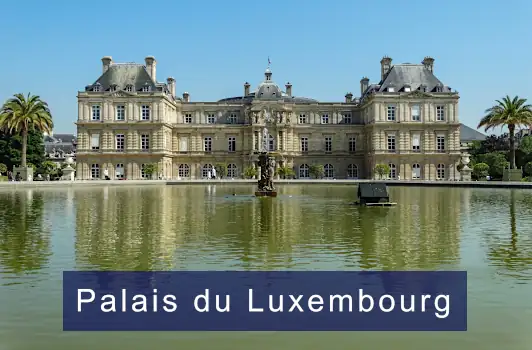
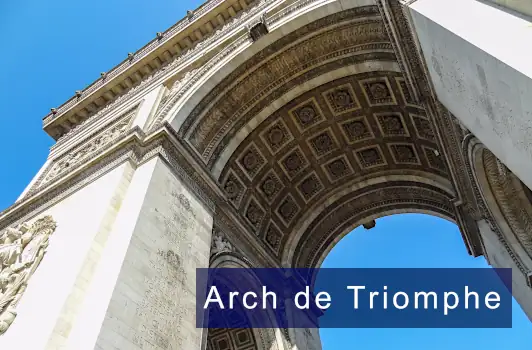
Palais du Luxembourg
Starting with the Palais du Luxembourg that was constructed in the early 1600s by the order of Marie de Medici, the widow of King Henry IV, this elegant palace has a storied history which weaves through the fabric of French politics and culture, and one of the popular historical Paris monuments, which is like a journey through centuries of French history from royal opulence to revolutionary fervour, culminating in modern-day politics as it is now home to the French Senate.
So no matter if you are an avid history buff, architecture enthusiast, or simply a curious traveller, the Palais du Luxembourg promises an unforgettable site standing prominently within the beautiful Luxembourg Gardens, and this is even more the case if you are lucky enough to venture inside, as it is only open to the public on specific days such as sometimes on the European Heritage Days held annually on the 3rd weekend in September.
Arc de Triomphe
Next we have the Arc de Triomphe that stands as one of the most significant, remarkable and popular Paris monuments, embodying a rich historical legacy that predates many of the city's renowned landmarks, including the Eiffel Tower. And when visiting this monument, you are experiencing a living testament to France's history, culture, and resilience, along with its majestic architecture, historical importance, and panoramic views, which makes this a must-visit destination for anyone seeking to explore the rich tapestry of Paris's heritage.
Luxor Obelisk
Paris is well known for its breath-taking architecture and iconic historical Paris monuments, but while many think of the majestic Notre Dame Cathedral or the grandeur of the Eiffel Tower when they consider Paris's most notable monuments, few realize that the oldest monument in the city is the Luxor Obelisk. Located in the centre of the Place de la Concorde, it is a relic from ancient Egypt, that connects the vibrant, modern city with the distant past, offering a glimpse into a time long gone but never forgotten, and with its enduring presence, the Luxor Obelisk stands as a testament to the legacy of human ingenuity and the timeless allure of ancient wonders.
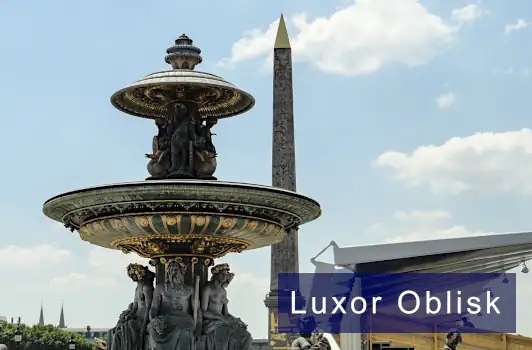

Sacre-Coeur Basilica
Then perched atop the hill of Montmartre, the Sacre-Coeur Basilica is another of the iconic and popular historical Paris monuments that offers breath-taking views of the city, and built in the late 1800s and early 1900s, this Romanesque-Byzantine basilica was constructed as a symbol of national penance following the Franco-Prussian War. With the basilica's gleaming white domes and its ornate interior adorned with mosaics and stained glass, this makes it a stunning example of religious architecture, so whether you are attending a mass, exploring the crypt, or simply absorbing the panoramic vistas from the dome, this historical church offers a profound and unforgettable experience.
Arc de Triomphe du Carrousel
Now the Arc de Triomphe du Carrousel is one of the lesser-known historical Paris monuments that often finds itself overshadowed by its more famous counterpart, the Arc de Triomphe, but despite its smaller stature and less prominent location, this triumphal arch possesses an elegance and historical significance that make it a noteworthy monument for any traveller’s itinerary.
Originally positioned on top of the arch were the Horses of St Mark, but these were returned to Venice after the defeat of Napoleon and the Bourbon Restoration, yet due to its popularity being strategically positioned between the Louvre Museum and the Tuileries Garden, plus its original role as a ceremonial gateway and a connector of historical and cultural spaces in Paris, it was decided that a copy quadriga based upon these horses was produced, which also included allegories of Peace riding in a chariot flanked by two gilded Victories.
Institut de France
Yet on the opposite bank overlooking the River Seine is the Institut de France, which is more than just a palatial building, it is a symbol of the enduring value of education and intellectual pursuit. From its origins as the College des Quatre-Nations that was constructed under the orders of Cardinal Mazarin in the 1600s, to its current status as one of the historical Paris monuments, it has played a crucial role in the cultural and intellectual life of France, and with its rich history, the 5 prestigious academies it oversees, plus its impressive library, the Institut de France continues to be a beacon of knowledge housing a vast collection of manuscripts, books, and rare documents, making it a treasure trove for scholars and researchers.

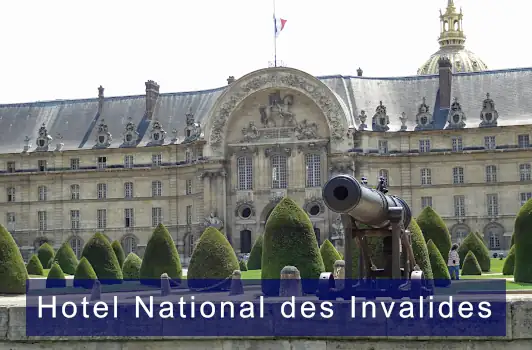
Hotel National des Invalides
And Les Invalides, officially known as the Hotel National des Invalides, also stands as one of the most distinguished historical Paris monuments, that offer visitors a unique experience, if it be exploring the grand halls, viewing the impressive collections in the museums, or paying respects at the tomb of Napoleon that’s interred in an ornate sarcophagus beneath the grand golden dome of the Dome des Invalides, which makes this one of the top places to visit that truly provides a glimpse into the past while celebrating the resilience and sacrifice of soldiers throughout history.
Barriere d’Enfer
For something completely different and one of the little-known Paris monuments, there is the Barriere d’Enfer, or Barrier of Hell, which is a pair of symmetrical neoclassical pavilions that were constructed under the supervision of Claude-Nicolas Ledoux in the latter part of the 1700s. These were geometrically precise with clean lines and imposing features, designed as part of a controversial wall, not for city defence, but to house toll collectors and facilitate the collection of taxes from traders and merchants bringing goods into Paris.
The Pantheon
But another of the remarkable and popular historical Paris monuments you should consider adding to your itinerary is The Pantheon, which was inspired by the classical architecture of ancient Rome, and originally built as a church dedicated to St. Genevieve, the patron saint of Paris, this neoclassical edifice now serves as a mausoleum for distinguished French citizens, with its crypt housing the remains of luminaries such as Voltaire, Rousseau, Victor Hugo, and Marie Curie, offering visitors a unique and enriching experience that captures the essence of French heritage.
La Grande Halle
Often overlooked, yet rising gracefully at the north-eastern edge of Paris, La Grande Halle de la Villette is a breath-taking example of adaptive reuse in architecture. Originally erected in 1867 as a vast iron-and-glass abattoir, which is a testament to the Industrial Revolution and the city’s culinary heritage, the structure has been meticulously preserved and reinvented. Today, even though classified as one of the popular historical Paris monuments, its luminous, open framework houses a multiplicity of exhibitions, concerts, festivals, and immersive experiences that attract visitors from across the globe year after year.

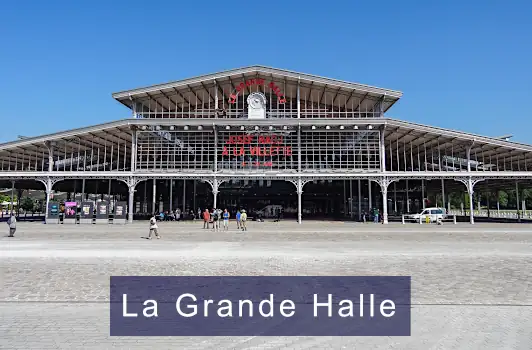
Notre Dame Cathedral
But no-one can visit Paris without going to see the Notre Dame de Paris Cathedral, which is located in the heart of the city on the Ile de la Cite island and stands as one of the most magnificent examples of Gothic architecture in the world. With its recognisable bell towers and flying buttresses, the intricate stone carvings and gargoyles plus the stained-glass rose windows, it is recognized as a UNESCO World Heritage site, and Notre Dame is not just another of the popular historical Paris monuments, it is still a functioning place of worship plus a symbol of French history, resilience, and grandeur that connects the past with the present, seeing millions of pilgrims and visitors each year.
Eiffel Tower
So as visitors continue to flock to Paris to bask in the shadow of this magnificent structure, the Eiffel Tower stands tall, not only as a testament to France’s cultural heritage but also as a reminder of the boundless possibilities of human imagination and we certainly could not finish this section without mentioning this popular monument.
But looking beyond its architectural brilliance, the Eiffel Tower represents the universal values of creativity, progress, and cultural exchange, which has become much more than just an iconic landmark, it is a global emblem of artistry and human achievement and from its humble beginnings to its current status as a symbol of love, innovation, and history, the Eiffel Tower remains one of the most treasured and popular historical Paris monuments recognised throughout the world.
Memorial Paris Monuments
Also, within the city you will find many different memorial Paris monuments that honour and remember significant events and figures in history. Visiting these sites provides a profound and reflective experience, allowing visitors to connect with the past and appreciate the legacy left behind, and below is a guide to some of the most remarkable Paris monuments you may also wish to visit when in the city.
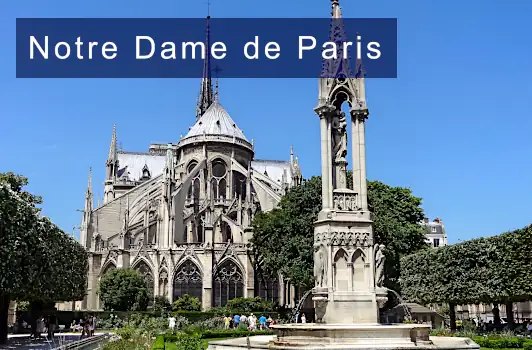
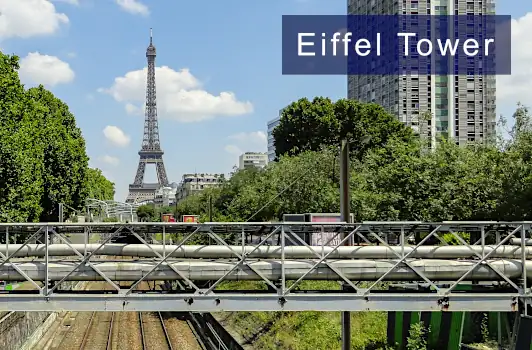
Monument a la Gloire des Armees Francaises de 1914-1918
Visiting this World War I monument at Place du Trocadero, that’s called Monument a la Gloire des Armees Francaises de 1914-1918, is not just a historical excursion, it is a journey through time, and invites visitors to honour the past, to reflect on the impact of war, and to remember the sacrifices made for peace. The serene atmosphere encourages quiet contemplation, making it a profound experience and a must-visit for anyone seeking to connect with history and pay tribute to the past.
Russian Expeditionary Force 1916 - 1918
Now this memorial is another one of the World War I historical Paris monuments, that offers visitors a striking statue that commands attention and evokes deep reflection. It was erected to honour the officers and soldiers of the Russian Expeditionary Force who stood side by side with their Allied counterparts in the trenches and battlefields of France. This monument serves not only as a tribute to their courage but also as a symbol of the enduring friendship and alliance between Russia and the nations of the West, but it is also an enduring legacy of the heroes who fought for a better world.
Komitas Monument
Visitors to this monument often describe a sense of profound connection and introspection, which celebrates Komitas for his work in preserving Armenian heritage through collecting and transcribing traditional folk songs, along with being one of the memorial Paris monuments. Yet the serene environment of the park also amplifies the emotional impact of the sculpture, and as one walks the quiet paths leading to the monument, the ambiance encourages a contemplative state, allowing individuals to pay their respects to the victims of the Armenian genocide in 1915 and reflect on the importance of remembering and learning from history.
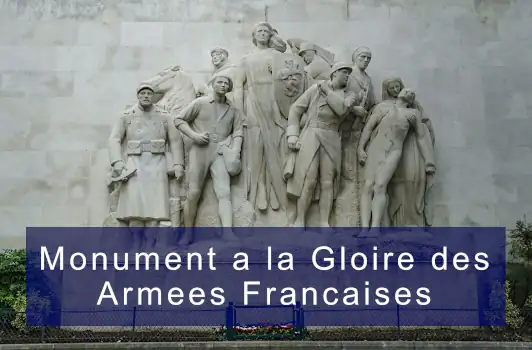

The Unknown Soldier and Eternal Flame
Now beneath the Arc de Triomphe, lies one of the most poignant symbols of France's enduring gratitude and reverence for its fallen soldiers, the Tomb of the Unknown Soldier and the Eternal Flame, and this is one of the popular historical Paris monuments that stands as a testament to the bravery and selflessness of those who have sacrificed their lives in warfare, with a re-lighting ceremony taking place every day and generations continuing to visit, so that the legacy of the fallen soldiers remains alive, ensuring that their bravery is never forgotten.
Memorial National de la Guerre d'Algerie
You have probably realised by now that Paris is a city renowned for its monuments, each marking moments both triumphant and tragic. Among its many sites of remembrance, the Memorial National de la Guerre d'Algerie (National Memorial to the Algerian War) stands as a solemn testament to a complex and deeply significant chapter in both French and Algerian history, and being one of the ultra-modern Paris monuments, visiting the memorial is not only to pay respects, but to engage with questions of memory, identity, and the enduring consequences of conflict.
Monument des Martyrs Juifs du Velodrome d'Hiver
Whereas located within an elevated square in the 15th Arrondissement offering lovely views to the Eiffel Tower, you will come across a sombre tribute to over 13,000 Jewish victims of one of Paris’s darkest chapters called the Monument des Martyrs Juifs du Velodrome d'Hiver. It was designed to commemorate the victims of the infamous Vel' d'Hiv Roundup, which occurred on 16th and 17th July 1942 when more than 13,000 Jewish men, women, and children were arrested from their homes across Paris and its suburbs and taken to a covered cycling stadium prior to deportation, which was not far from the present site of this popular historical Paris monument.
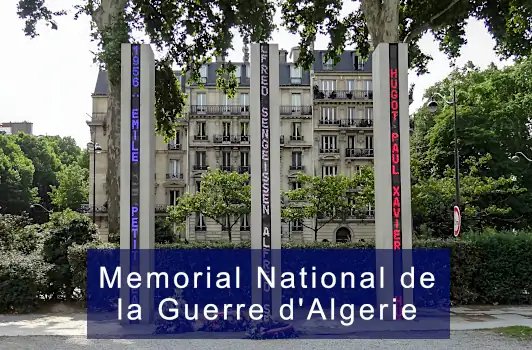
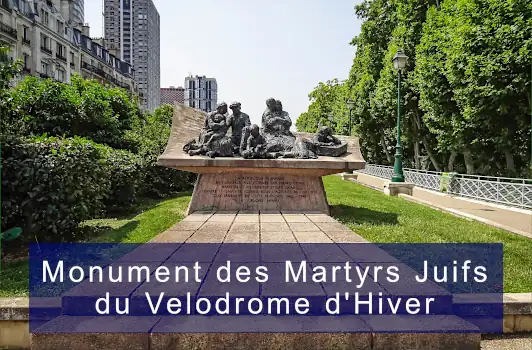
Memorial des Martyrs de la Deportation
Another of the memorials and Paris monuments relating to World War II is nestled at the eastern tip of the Ile de la Cite in Paris, just beyond the shadow of the majestic Notre-Dame Cathedral and although it is also lesser-known to many, it is still profoundly significant. The Memorial des Martyrs de la Deportation, dedicated to the memory of the 200,000 plus people deported from France to Nazi concentration camps during World War II, invites visitors into a space of solemn contemplation and historical reckoning, Inaugurated in 1962, its entrance is discrete, almost hidden, marked only by a set of descending steps leading visitors below the level of the river and the city streets, as it was deliberately designed to be underground to provoke feelings of confinement and isolation, so although not suitable for some people including those with mobility issues, it is free of charge to access.
Commemorative Paris Monuments
Now as you wander through the streets of Paris, you will find a multitude of monuments that commemorate significant events, figures, and epochs in French history, so this time we will look at some of the lesser known as well as iconic commemorative Paris monuments plus discover the stories they hold.
Thomas Jefferson Monument
One of the notable and popular historical Paris monuments is the statue of Thomas Jefferson that is located near the Hotel de Salm, which serves as a poignant reminder of the lasting impact of this American Founding Father on both sides of the Atlantic, and to celebrate his contributions to the principles of freedom and democracy, plus it underscores the profound connection between France and the United States. For visitors and Parisians alike, this statue offers a place to reflect on the shared history and values that continue to unite these two great nations.
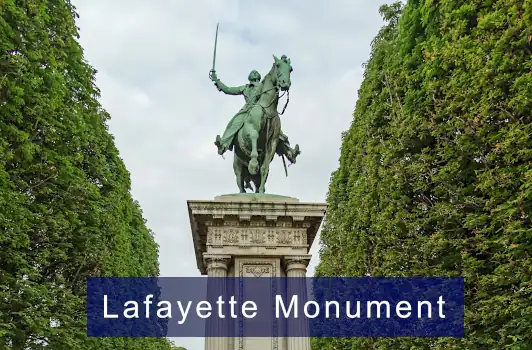
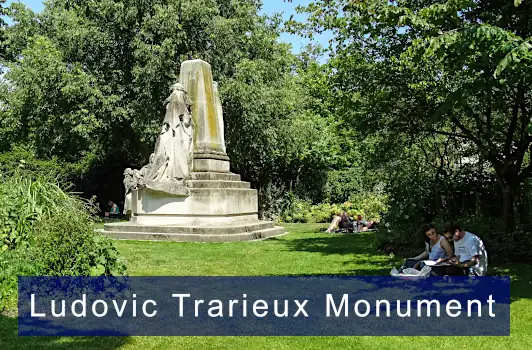
Lafayette Monument
The Monument to Lafayette in Paris also stands as a profound symbol of the enduring friendship between France and the United States. Erected to honor Gilbert du Motier, Marquis de Lafayette, this equestrian statue pays tribute to a man who played pivotal roles in both the American Revolution and the French Revolution. Known as a hero of two worlds, Lafayette's legacy is celebrated, reflecting his significant contributions to the ideals of liberty and democracy, this is one of the popular historical Paris monuments located at the Cours de la Reine next to the River Seine.
Charles de Gaulle statue at Place Clemenceau
Next is the Charles de Gaulle monument at Place Clemenceau in Paris, which offers visitors an enriching experience that combines historical significance with cultural exploration, and this is one of the historical Paris monuments that commemorates one of France's most iconic leaders, Charles de Gaulle, who led the Free French Forces during World War II and served as the President of France from 1959 to 1969, and it is situated close to the Petit Palais and a monument dedicated to Winston Churchill.
Ludovic Trarieux Monument
This Paris Monument to Ludovic Trarieux, located within the Square Claude-Nicolas Ledoux in Paris, France, stands as a tribute to one of the most influential figures in the history of human rights advocacy. Ludovic Trarieux (1840-1904), a prominent French lawyer and politician, is best known for founding the International League of Human Rights, an organization dedicated to defending individual liberties and promoting social justice, and today this monument serves as a constant reminder to visitors of the sacrifices made in the pursuit of human rights and the ongoing struggle for justice.
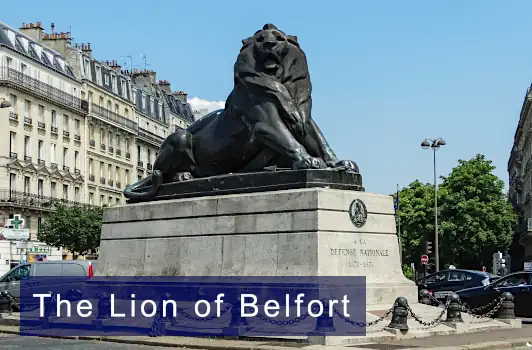
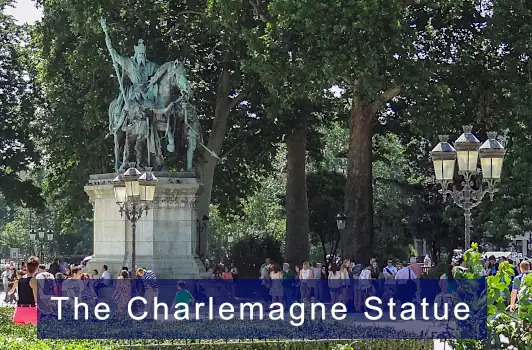
Lion of Belfort
The Lion of Belfort is much more than just another of the popular historical Paris monuments, it is an entry point into the heart of Paris’s history and identity. Through its symbolism, artistry, and location, it encourages visitors to connect with the struggles and triumphs of the past, while engaging with the vibrant life of the city today.
So whether you are drawn by an interest in history, a love of public art, or the simple pleasure of exploring a new corner of Paris, a visit to the Lion of Belfort, sculpted by Frederic Auguste Bartholdi who is more well known for the Statue of Liberty, is sure to leave a lasting impression, and as the Lion continues to keep its silent vigil over Place Denfert-Rochereau, it offers every passer-by a moment of contemplation, pride, and inspiration.
Charlemagne Statue
This popular historical Paris monument stands a testament to the legacy of one of history's most influential figures Charlemagne, also known as the Father of Europe, who was a medieval emperor that ruled much of Western Europe from 768 to 814, and was instrumental in the Carolingian Renaissance, a revival of art, culture, and learning, so today, this magnificent statue located by Notre Dame Cathedral is a must-visit for anyone with an appreciation for history, art, and the enduring impact of the Carolingian Empire.
The Colonne Vendome
When travelling around Paris you will come across a myriad of commemorative Paris monuments and architectural wonders, and among these iconic landmarks stands the magnificent Colonne Vendome, which was erected by Napoleon I to commemorate the victory of the Battle of Austerlitz, one of his most significant military achievements. It was modelled after Trajan's Column in Rome, and this monumental pillar, constructed using brass form from the seized cannons was inaugurated in 1810, stands proudly in one of Paris's most fashionable squares, surrounded by luxurious boutiques and prestigious establishments.
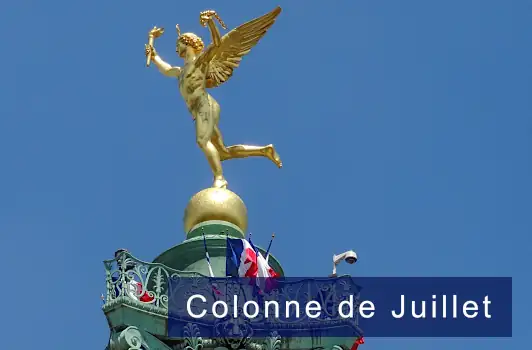

Colonne de Juillet or July Column
One place you should visit is the Colonne de Juillet, or July Column, which stands majestically at the Place de la Bastille, and this monument commemorates the July Revolution of 1830, that saw the downfall of King Charles X and the ascent of King Louis-Philippe to the throne. Today the column is a testament to the spirit of liberty and the enduring legacy of the French Revolution plus this is one of several popular historical Paris monuments that you can pay to go up and get a birds eye view of the area in addition to experiencing a piece of history and cultural heritage first hand.
Monument des Droits de l'Homme
The Monument des Droits de l’Homme, or the Monument to Rights of Man is a human rights monument nestled in the tranquil gardens of the Champ de Mars, within the shadow of the Eiffel Tower, and designed by architect Ivan Theimer, its forms are both ancient and modern, drawing inspiration from Egyptian temples and Masonic symbolism. This was inaugurated in 1989, marking the bicentenary of the French Revolution, an event that forever altered the course of history and enshrined the principles of liberty, equality, and fraternity.
Emmanuel Fremiet
The bronze statue depicting Emmanuel Fremiet is one of the commemorative Paris monuments found within the Jardin des Plantes, and more than just a sculpture, it is a piece of history, a work of art, and a symbol of the enduring legacy dedicated to one of France's greatest sculptors. Although Fremiet is most well-known for the gilded equestrian statue of Joan of Arc, this monument was commissioned by the Natural History Museum, which is located within the grounds of these botanical gardens, as he was once professor of animal drawing at this institution, and it invites visitors to appreciate not only the natural beauty of the garden but also the artistic achievements that have shaped French heritage.
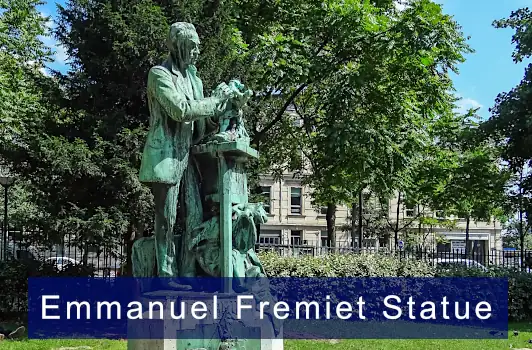
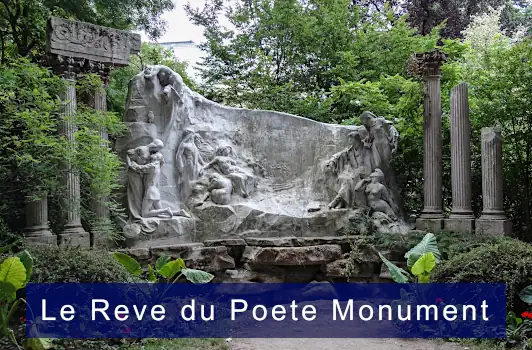
Le Reve du Poete
Then you have Le Reve du Poete monument, which translates to The Dream of the Poet, and erected in the early part of the 1900s, it was created by Alphonse de Moncel to recognise the renowned French poet and novelist Alfred de Musset, who contributed to the rich tapestry of French literature with some of his works even being put into films, and this large marble composition can be found within the little-known tranquil garden called the Jardin de la Nouvelle France located by the popular historical Paris monument The Grand Palais.
Hints and Tips for Visiting Paris Monuments
- Time Your Visit: Many popular areas like the Place de la Bastille can get crowded, especially during weekends and holidays, so visiting early in the morning or later in the evening can provide a more peaceful experience.
- Photography: The many statues and popular historical Paris monuments provide excellent photographic opportunities, so remember to bring a camera or your phone. In addition, consider the golden hour just before sunrise or sunset to capture some stunning pictures with a softer lighting aspect.
- Comfortable Attire: Wear comfortable clothes and shoes as exploring various different attractions can involve a fair amount of walking.
- Local Guides: Consider hiring a local guide to gain deeper insights into the history and significance of the historical Paris monuments you would like to discover, or alternatively, for a cheaper option you could book guided group tours.
- Free and Bookable: Although lots of the moments we have highlighted are completely free to discover, there are some such as the Eiffel Tower that you do have to pay if you wish to venture inside, and others like the Colonne de Juillet that have to be booked in advance due to a limited number of people allowed at a specific time, for instance.
- Planning: By planning ahead you can make the most of your time in Paris, and we would always recommend looking at tourist maps prior to give you more of an idea for where various monuments and attractions are located, but having these with you, will also be an invaluable aid for navigating the city.
So, although we have mentioned just a small selection, all these popular historical Paris monuments and numerous others are more than just tourist attractions, they are gateways to understanding the city's multifaceted past, and by exploring these sites, one can appreciate the layers of history that have shaped Paris into the vibrant and resilient city it is today. Each monument tells its own story, inviting visitors to delve deeper into the annals of time and discover the rich heritage that makes Paris truly unique.